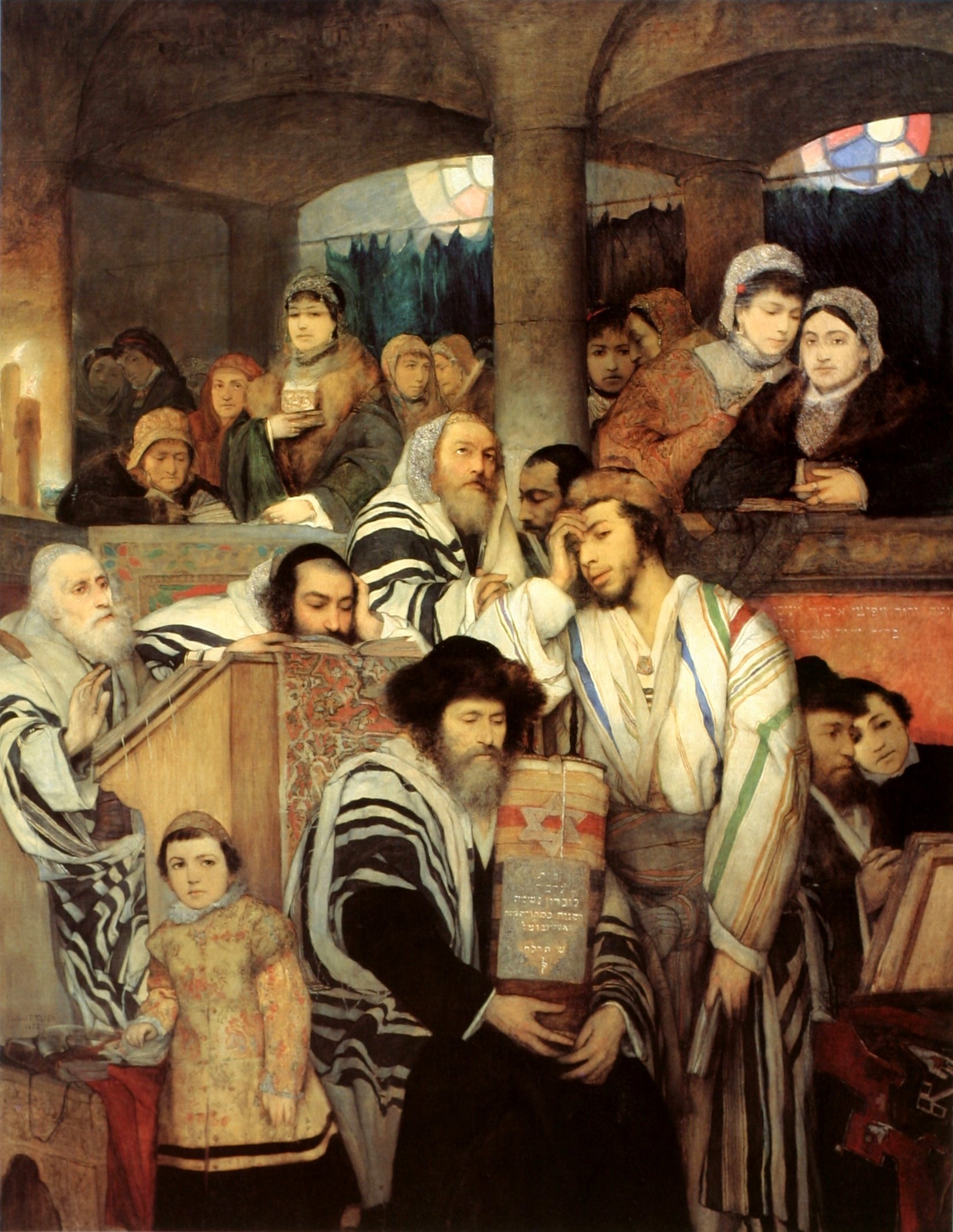On Narrative and Futurism: A Rosh Hashanah Reflection
Ellie Klibaner-Schiff, the Havurah Journal’s new editor, reflects on the powers of narrative and futurism as we enter the Jewish new year.
Maurycy Gottlieb, Jews Praying in the Synagogue on Yom Kippur, 1878
I see stories all around me. As a toddler, I used to write stories in crayon on folded pieces of paper about my adventures—whether a trip to the park or the time my sister bit my finger. I have continued writing to this day (though now usually in full sentences) and I’ll admit to sometimes imagining the people in my life as protagonists in their own personal narratives, with intersecting plots and overlapping characters.
Storytelling plays a key role in Jewish tradition, too. On Passover, we are commanded to tell the story of the Exodus from Egypt. And the Talmud is full of aggadot, stories told by Talmudic rabbis to illustrate and support their legal arguments. Beyond formalized Jewish stories, a wealth of Jewish folklore and mythology has carried across generations.
Today, in contemporary American culture, the art of story reigns supreme. Brands use narrative as a business and marketing strategy, and stories are seeping into the practice of medicine through the discipline of Narrative Medicine, which operates at the “intersection of humanities, arts, clinical practice, and health care justice,” according to Columbia University.
In response to the rise of narrative’s cultural power, over the summer, Parul Sehgal published an essay in The New Yorker critiquing the cultural role of narrative frameworks. Essentially, Sehgal argues that understanding the world as a web of stories blinds us to all that our stories exclude. When a real-life event or circumstance is wrangled to fit neatly into a narrative framework, its dimension can be lost. If life is interpreted through the prism of story, the distinction between living and telling blurs. Sehgal asks, “What is it that story does not allow us to see?”
Narrative can be seen as limiting our understanding of reality’s breadth and potential, because, as many learned in elementary school, every story must have a Beginning, Middle, and End. If the existence of The End is predestined at the beginning of a story, future possibility is constrained.
As I’ve been mulling over the limitations of storytelling, I’ve been wondering whether every narrative must really be constrained by its End. Reflecting recently, I realized that the traditions of Rosh Hashanah challenge this conception of narrative, which minimizes the stories we hear and limits those we tell, by allowing for an expansive form of storytelling that welcomes the future ahead.
Rosh Hashanah serves as an inflection point in the Jewish calendar. It marks the end of one year and the beginning of a new one. Within the Jewish historical narrative, Rosh Hashanah acts as a chapter break, a moment of reorientation and pause. While other holidays, such as Passover, emphasize the act of storytelling, Rosh Hashanah holds a formal storytelling role. By anchoring events and dynamics to a concrete timeline, Rosh Hashanah sets the structure of our narrative.
Throughout Jewish liturgy, Rosh Hashanah is called Yom HaZikaron, or the Day of Remembrance. In the sections of Genesis we recite during Musaf on Rosh Hashanah, we recall that “[God] remembered Noah with love,” and brought him to dry land after the flood. God looked towards the past and remembered for the future, developing Noah’s narrative. As we enter a new year, we ask God to remember us and our prayers, and we call upon the merits of our ancestors to protect us from present and future wrongs. The Jewish New Year is oriented around the act of remembering—of looking back deep into the past as we turn to face the future and enter a new chapter.
Archival Rosh Hashanah Card
Scholar and Jewish media creator David Zvi Kalman writes in his blog Jello Menorah that Jewish remembering of the deep past prepares us to see and appreciate the future. When our lives are oriented around a 3000-year-old story that we constantly connect to our present reality, it follows that the future must be vast before us. “The long Jewish journey invites us to imagine worlds that will emerge long after our own bodies are dust and ashes,” Kalman writes. Finding modern meaning in ancient stories invites us to now create meaning for the millenia to come.
In contrast to Kalman’s vision of the Jewish story enriching future opportunity, Sehgal understands stories as limiting the potential of the future. “We are hemmed in by stories that prevent us from seeing, or believing in, or acting on the possibilities for change,” Sehgal writes. However, Rosh Hashanah, with its invocation of Jewish remembrance, invites us to imagine a narrative shaped by the unknown, by the lack of a predestined End. The vision of Rosh Hashanah is one of a future, a new chapter, filled with expansive possibility and potential.
Sometimes I feel like the world is ending, and not without good reason. Threats such as climate change and wealth inequality loom large. I find myself feeling like the world—or humanity as we know it—must be ending soon, for where else could we go? But Rosh Hashanah opens a window for futurism, highlighting the expansiveness of the future ahead. The Jewish narrative is not shaped by a predestined Beginning, Middle, and End, as remembering deep history reminds us; rather, a new chapter in our collective narrative is just beginning.

